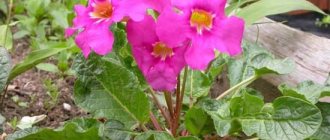Matthiola growing from seeds when to plant
For the older generation, our parents and grandparents, summer has its own unforgettable aroma - the smell of night violet. The flower resembles a sleeping beauty who, waking up in the evening, bewitches with her beauty. So it, inconspicuous during the day, enchants in the evening, intoxicating with its magical aroma. Now we will tell you about the flower - matthiola, growing from seeds, when to plant for seedlings, in open ground, we will reveal the nuances of care, we will talk about preventing possible diseases, how to get rid of pests.
How to grow matthiola bicornuum from seeds
If you decide to create a blooming, fragrant garden, and remember that a plant such as matthiola is best suited for these purposes, then you will begin to ask yourself many questions related to growing it from seeds and caring for it. Mattiola is a beautiful flower that enchants with its aromas. It can be grown from seeds. The only important thing is to know when to plant. In this article we will talk about all the intricacies of growing this plant.
Seed selection
Of course, in order to grow fragrant flowers you will need seeds. When visiting a specialized store selling seeds and plants for matthiola, you must definitely ask the seller that you are going to buy matthiola bicornuum, or leftwort bicornuum. This plant is inconspicuous, but has a pleasant aroma. Otherwise, they may sell you levka, called matthiola.
Levkoy is more decorative in its external beauty, but as for the aroma, it is much inferior in this quality to matthiol. When purchasing seeds of this plant, you must take into account that in 1 gram their number exceeds 1000 pieces. But, unfortunately, they cannot boast of a long germination period. And after 3 years, their germination rate will be only 5%.
Preparing the sowing site
In order to learn how to grow matthiola from seeds , it is important to read our publication carefully. To grow matthiola, consider many points. When choosing a place to plant seeds, you need to take into account the fact that matthiola flowers are not very attractive in appearance and are not at all decorative. They cannot be used to decorate a flower bed in your garden. But, nevertheless, by planting matthiola seeds next to bright and eye-catching flowers, you can thus do her a favor.
Mattiola can be perfectly combined with various red or pink border roses. They have virtually no aroma. They can be planted in a sunny, open place. Hidden behind low roses, mattiola will only spoil their splendor with its simple appearance, but as evening approaches it will intoxicate with its wonderful aroma.
There is no need to plant matthiola in a place that you will visit very rarely. This plant should also not be planted in the background, since it will not be able to create a beautiful bright spot, and in the shade of other flowers it will not be able to captivate with its wonderful smell.
In some cases, matthiola is planted in the garden, namely in a potato plot. There is a claim that the aroma of matthiola repels the Colorado potato beetle.
Matthiola seeds should not be planted in one place. In the evening, many gardeners simply want to take a walk around their plot, and a trail of unforgettable matthiola aroma will develop everywhere.
Whatever place you choose to sow matthiola, it must be in an open, sunny area.
Sowing time
Mattiol flowers require special attention. This requires proper planting and quality care. You can find a photo of this flower in this publication. Now it’s worth talking about such a moment as sowing time. Even a novice gardener can plant matthiola at home from seeds. Matthiola is a frost-resistant plant. For this reason, there is no need to select deadlines. It can withstand temperatures down to -3 degrees below zero. But still, it is necessary to take into account that the first shoots will appear only at above-zero temperatures, and the shoots that appear quite quickly may be subject to severe frosts and die. In some cases, winter planting of matthiola is practiced. But this can only be done if you live in the southern regions, or you will need to cover the sowing site with a special covering material.
Having determined the place for sowing matthiola, you should not thoroughly fertilize the soil. On well-fertilized soil, matthiola will develop excellent foliage. It begins to stretch, and its growth has a detrimental effect on flowering. As for ordinary soil, it is quite suitable for all needs. But matthiol has a negative impact on soil acidity. It requires liming or deoxidation of the soil. When choosing a place to plant matthiola, you should not stop at the lowlands. The root system of this plant is taproot. It is able to obtain water for itself from the deepest layers of the soil. But, unfortunately, matthiola does not tolerate excessive moisture. If mattiola gets wet for a long time, with the onset of a protracted rainy period, it will stretch out, lie on the ground, and may simply rot.
Matthiola is a southern flower. Large Greek territories were completely surrounded by its wonderful aroma 450 years ago. In those places, matthiola reproduced on its own. But as for the northern regions, it is imperative to provide it with proper care and sowing.
Sowing matthiola
Matthiola does not need to be sown in rows or in a row method. Now it’s worth talking about how to sow matthiola correctly.
- You just need to level the area, dig it up and sow the existing seeds in a scattering.
- Then you should sprinkle them with a small amount of earth and compact them a little.
- After the first shoots appear, matthiola does not need to be thinned out or broken through. If the weather is very hot and dry, then in the first days it is better to water the matthiola to allow the first shoots to appear and take root.
- Matthiola does not bloom for a long time. After the seed pods are formed, its aroma will become almost unnoticeable. If you do not need seeds, then prune the plant to 24-30 cm. After a certain period of time, matthiola will grow again and give you an amazing aroma. You can not prune the entire plant, but only a certain part of it.
- Do not rush to pick off the seed pods. Give them time to mature well. But you should not let them open completely, as you will lose the seeds. If the weather is wet, the matthiola pods can be cut off when they are not ripe. But then, spread them in a dry place and dry well.
Let's sum it up
Matthiola evening aroma is a beautiful and at the same time not whimsical plant. It is worth growing it correctly from seeds and after a while you will be able to enjoy the amazing aroma. There are not many methods for growing matthiola. To be able to quickly enjoy its enchanting aroma, in rare cases, sowing matthiola seedlings is used. Due to the presence of a tap root in Matthiola, it was previously believed that if the transplant was carried out together with an earthen ball and at the age of 2.5-3 weeks, then the survival rate would be excellent. Planting matthiola in seedlings is rarely practiced due to the short flowering period, and the acceleration of growth lasts only 2 weeks. Based on this, as a rule, direct sowing of seeds in open soil is used. Mattiola is not afraid of pests; she practically does not suffer from various bacterial, fungal or viral diseases. Wonderful aroma, unpretentiousness, ease of care - all these advantages apply to nondescript matthiol. Therefore, you should choose this flower to plant in your garden.
Video on the topic: How to plant matthiola at home. Sowing, planting, growing matthiol. Planting matthiola
Also read:
- How to grow perennial plants for your garden
- Planting low-growing perennial flowers yourself
- What annual flowers bloom all summer. Catalog…
- We arrange beautiful flower beds ourselves and…
- Interesting DIY garden crafts. Ideas and photos
- How to plant ranunculus correctly. All the secrets of growing
- How to grow lobularia. Secrets of planting and care
- Catalog of unpretentious and small perennials.…
Mattiola gray
This is a real garden decoration. It is not as fragrant as Matthiola bicorna, but the color palette is so rich that it has become a priority.
Mattiola gray varies:
Stem shape: straight, branched.
Size (15 – 80 cm) of the bush:
- dwarf (20 – 30 cm);
- medium (from 45 cm);
- tall (60 – 80 cm).
Flowering period:
- summer (from July);
- autumn (mid-August – September);
- winter (blooms in the 2nd year after sowing, April - May).
Each variety has its own characteristic features. Taking these features into account, landscape designers create real garden masterpieces.
Based on the flowering period (July - September), varieties differ:
- early;
- mid-early;
- average;
- late.
You definitely need to know what the inflorescence will be like: spike-shaped or racemose; its fullness, how many flowers (simple, double). Size – large, small (from 3 cm or more). Color: lavender, soft coral, burgundy, burgundy.
- Dwarf. Only 20 cm, double color, dark shade turns into white.
- Dwarf. Chic balcony decoration. Planted in garden containers, ridges, along borders.
- Variety Sugar with spices, inflorescence fullness – 50%.
- Brand Prestige, cold-resistant, long-flowering, fragrant, terry up to 60%.
Medium height
- Kats (apricot, yellow). It blooms very early, height up to 64 cm, used for mixborders, compositions, bouquets.
- Swing (Gavrish brand). The flower size is up to 5 cm, blooms from June to September, stands well in a bouquet.
- Vintage, colors peach, lilac, pink, copper, burgundy. Height 50 cm, flower 5 cm, double size more than 50%, late flowering.
Tall left-handed
Reach 80 – 100 cm, beautiful in bouquets and flower arrangements.
- Lucinda, blooms for a long time (June - October), flower diameter 7 cm, inflorescence raceme.
- Opera Francesca. Very fragrant, blooms long and profusely.
- Liverpool. Blooms late, single stem, loose cluster of inflorescences, snow-white flowers, grown in a greenhouse in autumn - winter.
Varieties of matthiola
The height of herbaceous plants can reach 1 meter, and some species grow only up to 15 cm. The stems are woody or herbaceous; some of them are naked, others are pubescent.
The shape of the leaves can be carved, lanceolate, obtuse, oblong or ovoid.
Matthiola flowers are double or simple, which are collected in spike-shaped or racemose inflorescences. The petals vary in shades of violet, pink, magenta, lilac, yellow and white. The fruits look like pods filled with flat seeds.
But the main feature of the plant is that it exudes a magical fragrant aroma, which appears in the evening and at night with the opening of the flowers.
The Matthiola genus includes more than 50 species. They all differ in the time and period of flowering, external structure and characteristics of cultivation and reproduction.
Gardeners commonly grow matthiola bicornuum and matthiola hoary .
Many have heard, but not everyone knows how to properly care for the Sansevieria flower.
Matthiola bicornuum
Its other name is “night violet,” since the color of its flowers resembles the tones of a violet , and the plant delights with a pleasant smell precisely at sunset.
The variety is an annual crop. The flowering period is the entire summer season.
The stems grow up to 30−50 cm, forming spreading and branched bushes. Double-horned matthiola is distinguished by oblong, oval and pubescent leaves. The most common shades of flowers are lilac, lavender, greenish-purple and white. The flowers are closed during the day and open in the evening, releasing a strong and pleasant aroma.
The pod-shaped fruits have two short horns at the top. Gray-brown seeds of small size, germination retention - 2-3 years.
Popular varieties of matthiola bicorne:
- "Night Violet" The type of aerial inflorescences is racemose. The leaves are coarsely toothed, the length of the stems usually reaches 30 cm. With the first rays of the sun, the flowers and leaves curl up, and with the onset of evening they open again and fill the air with a pleasant smell. Used not only in the garden, but also in decorating balconies and terraces, this flower is a real queen of the night.
- "Lilak." The shape of the leaves is linear, coarse-toothed. Densely branched stems grow up to half a meter. The loose racemose inflorescences have a strong, enchanting aroma. Found in Moorish lawns and mixed ridges.
- "Evening scent" Lilac and pale lilac flowers with highly branched stems can reach a height of 40−50 cm. Abundant flowering is accompanied by an intense aroma in the evenings and nights. The bushes are formed by loose racemose inflorescences.
- "Star Light". It is a variety mixture with different shades of matthiola flowers. They are characterized by low decorative value, but have a refined aroma. They are planted next to the house, on benches, along borders and garden paths.
Mattiola gray
Another name is “gray-haired lefty.” Varieties of gray-haired gillyflower can be annual or perennial. Surprisingly, sometimes the same species has flowers of double and simple types. Belongs to the Cruciferous family.
Levkoy has a delicate spicy aroma. Leaves and stems are pubescent and whitish. Rich range of color shades. Stems with spike-shaped inflorescences can be 20−60 cm in height. The period of preservation of seed germination is 4-6 years.
Varieties of gray-haired gillyflower are classified by flowering period (summer, autumn, winter), by type of stem (single, branched) and by type of flowers:
- Bouquets . Summer flowering season. Attractive flowers reach a diameter of 4 cm. They come in different shades. The central and lateral stems of the bush grow almost the same height (25−30 cm).
- Gigantic . Bomb-shaped flowers grow more than half a meter. Characterized by late flowering until the first frost. Large flowers with a diameter of 5-6 cm are held on racemes reaching 20 cm in length. The central shoots reach maximum height faster than the lateral shoots. Among the well-known varieties, “Northern”, “Vygonochny”, “Gigantic Tree-like” should be highlighted.
- Quedlinburgskie . Double and non-double characteristics of flowers are already clearly expressed at the seedling stage.
This group of plants is divided into the following 4 subgroups:
- Six-shaped. The most valuable subspecies with dense flowers, the diameter of which reaches 6 cm. The height of the stems is 50−80 cm. The loose inflorescences are distinguished by one high central one.
- Late high ones. They reach a height of 50 cm. Densely branched stems form pyramidal bushes. Plants with large, densely double flowers.
- Early high. A spreading bush with bright flowers grows between 60-70 cm. Large leaves predominate on tall stems.
- Early low. Flowers 20-40 cm high form a spherical bush.
- Erfurt . Germany has been breeding this variety since the 13th century. Lush bushes usually grow short, but some specimens reach 40 cm. Short-branched gillyflowers have flowers of rich colors with a diameter of 4 cm.
- Large-flowered tree-like . Often the stems grow up to 1 meter. The racemose inflorescences are dense and branch only from above. Flowers are 6 cm in diameter. Famous varieties are “Diana”, “Tsartroza”, “Illusion”.
- Spreading . Levkoi have powerful and branched tall stems with loose tassels. Large flowers are distinguished by a variety of colors and long flowering; a mix of different flowers looks especially beautiful.
- Pyramidal . Pyramid-shaped bushes can be dwarf, medium and giant, which are distinguished by red, purple, pink and white flowers.
- Single stem . The stem reaches a height of 1 meter. The flowers are large and bright, double; Delicious bouquets are collected from them. The main varieties grown are “Chamoperosa”, “Gelgelb”, “Sensation”, “Terracotta”, “Katz Ruby”, “Vintage”.
Matthiola bicornuum
One-year-old. A modest flower has extraordinary magic. The stems, branching, grow up to 30 cm, are covered with thin linear leaves. The flowers are small, in various shades of lavender, lilac, reminiscent of lilac. In the evening they release a rich, bright aroma. They close during the day and bloom after sunset, in cloudy weather.
Flowering is short, lasting several days. The plants are fading and fruits are formed - a long pod filled with ripening seeds. When dry, it bursts, forming self-seeding. Loves the sun, in the shade the stems stretch out, lie on the ground, tolerates the first light frosts well.
Varieties without clear differences are usually mixed. The height of the stem is 30 – 50 cm. In sunny, fertile areas they form fluffy, branched plantings.
Mattiola sowing seeds for seedlings
In early spring, amateur gardeners begin to plan future plantings, purchase seeds, and determine the timing of sowing seedlings in open ground.
When to plant seedlings
To grow high-quality planting material, it is necessary to sow seeds for seedlings in late March - early April, then flowering will begin in June.
The necessary conditions
Levy seedlings are bought in a nursery, at a specialized market, or grown independently, enjoying the results of their labor.
By providing favorable conditions, grow healthy, strong plants. Necessary:
- prepare seeds for sowing;
- prepare a nutritious soil mixture;
- do not violate sowing technology;
- adhere to the basic rules of caring for seedlings;
- observe temperature and light conditions;
- harden young plants before planting in open ground.
- By observing these conditions, you will get a positive result.
Preparing seeds for sowing
When buying seeds, be sure to check the expiration date. Good germination lasts up to 6 years. Expired ones may produce zero shoots. Special stimulating procedures will help speed up their germination.
Soak the seeds in water for a day to swell. Those that float to the surface are not suitable for sowing, discard. Wrap high-quality seeds in a damp soft cloth or a bandage folded in several layers. Place in a cool place with air temperature +4 +5 °C, for example in a refrigerator.
Containers for sowing
While the seeds are hardening, prepare the containers. Large ones are needed for sowing; seedlings are transplanted into small ones after picking. The dimensions of the container depend on the amount of seed, there are:
- containers with a transparent lid;
- plastic boxes;
- plastic or wooden boxes.
There should be a sufficient amount of various small containers.
It is convenient to use peat cups for planting in the ground; the roots are not injured, the seedlings quickly take root in a new place and do not get sick. You can use available materials.
Soil (composition, characteristics)
Take your potting mix preparation seriously. Beginner gardeners buy ready-made “Universal soil”. We recommend preparing nutritious, fertile soil yourself. Ideal: black soil, loam or sandy soil flavored with turf.
For germination and emergence, seeds are sown in a mixture consisting of 3 parts turf and 1 part sand.
After diving, the seedlings are transplanted into pots filled with an earthen mixture of sand, turf and leaf soil. Leaf soil, not as nutritious as turf, but light, loosens it well.
Seedling method
If you want to get flowering in June, then you need to use the seedling growing method. Seeds should be planted in containers at the end of March or April.
Preparing soil and seeds
The soil and containers must be prepared 2 days before the upcoming planting. In this case, the following simple rules must be observed:
- Treat the planting box with a solution of potassium permanganate . Then dry thoroughly. Such actions will allow you to disinfect the container, eliminating all harmful microorganisms.
- Place some pebbles at the bottom of the box to act as drainage.
- Place a substrate in a box, which will consist of sand and turf soil. Take them in a ratio of 1:3.
- Water the soil with water with a slight addition of potassium permanganate.
To speed up the germination of seeds, you must first soak them in boiled water. Leave them for a day, and then put them in a damp cloth. Place in the refrigerator for another day.
Seed sowing technology
Seeds prepared for planting are sown into seedlings. There are two opinions about where to sow seeds for seedlings. Some gardeners prefer to sow directly into peat cups. Others adhere to the common method - sowing in a large container, followed by transplanting into separate containers.
The freshly prepared earth mixture is distributed into containers, moistened, and disinfected with a solution of potassium permanganate. Spread the gilly seeds on the surface of the soil or make shallow furrows. Maintain a distance of 2.5 - 3 cm. You can sow in a chaotic manner. Sprinkle a small layer of sand on top.
An excellent option is when the seeds are sown in a container with a transparent lid. If this is not the case, stretch cling film, cellophane or cover it with glass over the container to create a humid and comfortable microclimate.
Mattiola in landscape design
Mattiola in landscape design photo
Decorative varieties with double flowers will decorate a flowerbed; when cut, they will delight you for about 2 weeks.
Thanks to its wonderful aroma, matthiola is planted near the windows of houses to enjoy on summer evenings.
For landscaping terraces and balconies, they are planted in containers.
Good neighbors in the flower garden would be cornflower, thyme, thyme, decorative wormwood, rosemary, mignonette, lavender, and phlox.
Caring for seedlings and seedlings
Do not water until germination. The container is placed in a dark, warm place (temperature 15 – 20 °C). The seeds germinate in a week, remove the film, and water with a spray bottle. Further development and growth of seedlings occurs in the light. To ensure that the stem develops strong and does not stretch, the plants are kept at a night temperature of 10°C, raising the daytime temperature to 15°C.
In the second week, after germination, picking is done. The stem of a young left-handed plant is very fragile, so moisten the soil, carefully, using a wooden spatula (ice cream stick), remove the plant with a small lump of earth.
For good development of the root system, add a little hydrogel to the soil. Picked plants are transplanted into separate containers filled with a 3-component soil mixture. See the section “Soil (composition, characteristics)”. Keep in a bright, cool place.
To prevent plants from experiencing temperature shock when transplanted into open ground, a hardening procedure is carried out (accustomed to lower temperatures and fresh air). Ventilate the room regularly, open the window. After a few days, take the seedlings outside, gradually increasing the time, protecting them from direct sunlight. Hardening begins 2 weeks before planting in open ground. Water regularly, when true leaves appear, apply the first fertilizing.
Seedlings are planted in the garden plot at the end of April. The prepared holes or grooves are filled with water to form an earthen slurry. Plants are installed together with a lump of earth or in a peat cup, allowed to absorb water, sprinkled with earth, and compacted well. Low varieties are planted at a distance of 15–20 cm, tall varieties – 25–30 cm.
Perennial Levkoy: planting and care
Levkoy needs a well-lit place. It is better that there are no other representatives of Cruciferous plants in the area before this (the soil may be infected with a fungus). Matthiola grows well in nutritious, airy soil with a neutral pH. A heavy substrate will lead to death.
Planting is carried out using the method of transshipment together with a lump of earth. The seedlings are buried at the level of the rhizome, leaving a distance of 17-20 cm. If planted densely, various diseases may occur. It is recommended to plant in the late afternoon, in rainy weather.
The plant is not difficult to grow; the most important thing is to choose the right place for planting and water it.
| Parameter | Recommendations |
| Watering | Regularly, in small dosages. In the evening, the bush can be sprayed to make the aroma stronger. |
| Loosening | Perform periodically to improve soil breathability. Avoid overgrowing with weeds; they take away nutrients and cause diseases. |
| Top dressing | When planting in a nutrient substrate, there is no need to apply fertilizer. In spring, you can use complex mineral mixtures for flowering plants. Organic is not recommended. |
When to plant seeds in open ground, choice of location, soil
Mettiola gray is grown by sowing seeds in open ground. The most favorable time for sowing is the end of April. Flowering will begin in two and a half months. A prerequisite for growing is the correct choice of location for the flower bed. The area should be open and sunny. Rainwater does not stagnate, and when watered, it is quickly absorbed into the soil. Soil: fertile, neutral or slightly alkaline, sandy loam or loamy, with some turf.
Organic natural fertilizers - humus, compost (7 kg per sq. m), liquid complex fertilizer are applied in the fall if the soil is severely depleted. Make sure that in the chosen place, representatives of the Cruciferous family have not previously grown; seedlings may become infected with blackleg or clubroot.
Flower care (watering, fertilizing)
Care means carrying out regular activities:
- weed control (weeding);
- loosening of rows and holes;
- watering;
- feeding;
- pest control;
- prevention of diseases.
Levkoy does not tolerate waterlogged soil; mulching rows to preserve moisture is not recommended. Watering is carried out if necessary to prevent wilting of foliage and inflorescences.
During the watering process, the plants are fed. Mineral fertilizers are used; during the flowering period, phosphorus-containing and potassium fertilizers are used. Biohumus is used as a top dressing; it accelerates budding and improves immunity. A drug that reduces stress during transplantation is Multiflor Aqua. “Stimul” has a general strengthening and stimulating effect.
How to care for flowers planted in open ground
Any damage to the roots is stressful for gilly leaves. When transplanting to a permanent place, you should carefully transfer the seedling into the hole along with a lump of earth. To prevent the lump from crumbling and damaging the root system, it is pre-moistened. It is not recommended to plant seedlings in hot weather.
The holes for planting are watered with water, lightly mixed with soil until the consistency of liquid porridge, so the roots of the plant will take root faster. There is no need to add any additional fertilizers. The hole is covered with earth and compacted well.
Levkoi do not require special care. It is enough for them to perform the simplest procedures:
- Moderate watering without waterlogging the soil.
- Loosening after watering and rain.
- Weeding.
- Feed once a month with ash or mineral mixtures containing potassium and phosphorus.
Possible pests: cruciferous flea beetle and cabbage butterfly caterpillars. To combat them, you can use ash solution, tobacco dust or insecticides.
Florists use two-thirds of the gillyflower inflorescences when making bouquets, and they are able to stand in water for almost half a month without losing their pristine freshness and beauty. In landscape design, gilly leaves are suitable for the first rows of flower beds, decorating terraces and balconies. They are planted in flower beds, ridges, flowerpots and containers.
Diseases and pests (treatment)
Diseases
Levkoy is susceptible to disease, the plant will lose its decorative and beautiful appearance. Diseases:
- Fusarium is an asymmetric wilting of a plant. A brownish-pink bloom and black stripes appear, and the leaves wither. Quicklime is used to disinfect the soil and treat it before sowing with Ditan M-45 solution.
- Blackleg is a fungal disease. It affects young shoots and adult plants when the soil is very waterlogged. The base of the stem rots, the leaves turn yellow and wither, and the plant dies. The soil is etched with a manganese solution and a fungicide solution.
- Clubroot attacks cruciferous crops. This is a parasitic fungus that forms growths and swellings on the roots. The plant turns yellow and fades. As a preventive measure, add wood ash, lime milk, and treat with the drug “Hom” according to the instructions.
Pests cause irreparable harm
The cruciferous flea beetle is the most dangerous pest. In a few days it can destroy all plants. Spray with a solution of “Aktelik”, “Decis”, “Intavir”.
The first butterflies appear in April – May. Poisonous caterpillars cause damage by eating leaves and flowers from the inside and then from the outside. They live for several weeks. You can collect caterpillars and spray them with a solution of Karbofos, Kinmiks, Aktelik.
Attention! Plant protective plants: valerian, lemon balm, marigolds.
Matthiola bicorne, evening scent, bicorne mix
When to plant seedlings
Mattiola two-horned or night violet is one of the most popular flowers among summer residents. With its extraordinary aroma, it invites you to the gazebo for an evening cup of tea or to sit on the porch, look at the stars, listen to cricket songs. When to plant seeds for seedlings?
To get early flowering, seeds are planted on seedlings in March. The best germination will be on loamy, sandy soils. But, in principle, the plant is not whimsical; it will grow anywhere with regular feeding. Strongly grown plants do not tolerate transplantation well, so many people prefer to sow seeds directly into the ground.
When growing seedlings, adhere to the basic rules:
- compliance with the temperature regime (+12 +15° C), when seedlings appear, the temperature drops to +10° C;
- moderate watering;
- prevention of blackleg disease;
- when 2 true leaves appear, dive and transplant into single containers;
- The seedlings are hardened for 2 weeks;
- a plant with five leaves is transplanted into the ground.
For planting seedlings, choose sunny areas; in the shade, the night violet stretches out strongly and lies down. The chosen place should be dry, without stagnant water.
Mattiola care
The culture is unpretentious and caring for it is easy. It comes down to regular watering, but in small portions so that the soil is not flooded, weeding and fertilizing. Weeding should not be neglected; the night violet can suffer greatly from weeds. Levka does not need organic matter; you only need to add mineral complex compounds under it, and this is enough to do once in the spring. If the soil on the site is fertile and humus, then the plant does not need to be fed. However, too fertile soil is undesirable for this crop, so that the bush does not grow to the detriment of flowering. Light requirements are low; gillyflower can grow well in partial shade.
Growing from seeds in open ground
The best germination will be on loamy, sandy soils. But, in principle, the plant is not whimsical; it will grow anywhere with regular feeding.
Matthiola bicorn seeds are small, so that when sowing they fall evenly into the soil, mix them with dry sand. In open ground, flowers are planted in holes, grooves, and randomly distributed over a small area. The main thing is that it is a well-lit place, then the flowering will be abundant.
Advantages of the method:
- is not injured during transplantation;
- rises quickly;
- not afraid of cold snaps and slight frosts.
First, the area is dug up or loosened with a hoe, leveled, seeds are sown, sprinkled with a little earth, and watered. In care, adhere to moderate watering. If desired, very dense shoots should be thinned out a little.
The plants stretch well, the stem is thin, long, dotted with small flowers. To grow as a bush, plant them next to larger and stronger specimens so that they support the graceful matthiola. We recommend sowing flowers to extend the flowering period.
Types and varieties with photos
Under natural conditions, 50 species of plants belonging to the genus Matthiola grow, several species have been cultivated. In the temperate climate of the middle zone, two types of plants are grown as ornamental open ground crops:
- matthiola bicornuum;
- matthiola gray.
Matthiola bicornuum
Matthiola bicornuum is an annual crop. Height is about 50 cm. The bush is spreading and branched. The leaves are oblong, oval, pubescent. Blooms all summer, starting in June. The inflorescences are racemose, consisting of small flowers of greenish-purple, white or yellow.
A plant with a strong pleasant aroma is especially noticeable in the evening and at night, since the flowers open after sunset and are closed during the day. At the end of summer the fruits form. These are quite long pods with small horns at the top.
The seeds are flat in shape, gray-brown in color, and small in size. Seed germination persists for two to three years. You can sow seeds in the ground in the fall. On the horticultural market, the species Matthiola bicornata is represented by several varieties. Most Popular:
- Evening scent.
- Star Light.
- Night violet.
- Lilac.
Variety Evening aroma
The most popular variety has a strong, pleasant aroma. The bushes are of medium height - 45 cm, have an erect stem with a large number of branches. Flowers are lilac in color, collected and loose racemes, close at sunrise, bloom in the evening. Flowering is abundant. Can grow in partial shade.
Varietal mixture Starlight
The flowers of this variety are not very decorative, but have an exquisite aroma; the colors can be very different. Height no higher than 30 centimeters. The variety mixture is recommended to be used to decorate lawns, balconies, and garden paths. Usually flowers of this variety are planted near benches and under the windows of the house. The plant is not afraid of slight cold snaps (-5° C).
Variety Night violet
An annual plant - matthiola Night violet, low, maximum height 25 centimeters, cold-resistant, loves sunny places. The flowering period is long. When planted at the end of April, beginning of May, flowering begins in June and ends in September.
It grows quickly, reaching half a meter in height. The stems are densely branched, covered with large-toothed leaves. The racemose inflorescences are closed during the day and bloom in the evening, spreading an exquisite aroma and can be used for cutting.
Matthiola Night Violet combines well with other flowering plants and can be used to decorate mixed flower beds. The plant looks great against the backdrop of green lawn grass, next to gazebos, terraces, and benches.
Variety Lilac
Mattiola Lilac is a cold-resistant, annual plant that prefers well-lit places. The stem is of medium height (50 cm), densely branched, covered with large, serrated leaves.
The inflorescences are racemose, lilac in color, bloom at night, and have a charming aroma. The onset of flowering is early, only 60 days from sowing, and long-lasting (2 months). The Lilac variety is usually planted in flower beds located next to gazebos in combination with other flowers.
When to plant a plant in Siberia
Matthiola two-horned, beloved by many, is easy to care for and has another important advantage. Not afraid of cold snaps and small frosts. Withstands temperatures down to -5 -7°C. The question of when to plant and in what way is of interest to beginning amateur gardeners. Our recommendations: use the method of direct planting seeds in open ground.
The optimal time is the beginning - the first ten days of May, the top layer of the earth will warm up enough, there will be good germination. Sow seeds every 2-3 weeks to ensure long flowering. The rules of care in this region are not specific. Mattiola gray seedlings are planted at the same time.
How to care for matthiola bicornuum seedlings
What to do after sowing matthiola bicornuum seeds? There are a number of measures for caring for seedlings that need to be performed immediately after planting and carried out subsequently:
- Immediately after sowing the seeds, you need to thoroughly moisten the substrate (as mentioned above) and cover the container with a lid, film or glass to create a greenhouse. After emergence of seedlings, the cover must be removed!
- Before emergence, you need to ventilate the greenhouse daily and wipe off condensation from the covering material to minimize the risk of mold.
- Observe temperature conditions. Immediately after sowing, you need to place the bowl in a room with a temperature of 22-25 degrees Celsius. After emergence of seedlings, you need to lower the temperature to +18°C during the day, +16°C at night.
- The soil should always be moderately moist. After the emergence of seedlings, even the top layer should be moist; if necessary, water from a spray bottle with clean, settled water at room temperature. After seed germination, you need to water when the top layer of soil dries out; water should not get on the plants themselves!
- The seedlings should be illuminated for 12-14 hours, so you need to place the container on the lightest windowsill and it is advisable to use special phytolamps. Without normal lighting, the seedlings will begin to stretch out and weaken.
Use in folk medicine
Levkoy is known as an antimicrobial, anti-inflammatory, cardiotonic and diuretic. The leaves contain a large amount of essential oil and are used for headaches and migraines. Seeds are a source of biological steroids and alkaloids. A tincture of leaves and seeds helps with rheumatism and gout.
In this article, we tried to clearly talk about the types of matthiola flower, growing from seeds, when to plant for seedlings and in open ground, methods of pest control, types of fertilizing.
Which variety of gillyflowers should I choose for planting?
It is not necessary to know all the nuances of classification. When choosing seeds, you must carefully read the description of the variety, paying attention to the following parameters:
- plant height;
- size and shape of the inflorescence;
- flower size;
- flowering time;
- best before date.
Popular varieties with photos
- Variety Mammut Excelsior (Mammut is the most excellent).
Belongs to the group of single-stem varieties, usually reaches a height of 70-80 cm, forms a long dense inflorescence on a powerful stem, consisting of double flowers up to 5 cm in diameter. It has many shades: red, yellow, white, apricot. Good for cutting. Tall varieties: Fox (pink), Step (red), Excelsior (different shades), Miracle.
- Variety Thumbelina.
Belongs to dwarf varieties. The height of the plant is no more than 30 cm. Dense pyramidal inflorescences consist of large double flowers. Shades from white to dark purple. Beautiful in a flowerbed, due to its compactness it feels great in pots. Dwarf varieties: Gnome (various colors), Sunny Bunny (yellow), Lapis Lazuli (blue), Ten Vic (various colors), Intuition (20 cm high).
Thumbelina, mixture of shades
- Variety Ten Vic.
It has lush inflorescences of densely double flowers. Height – 30 cm.
Ten Vic pink
- Variety Snowflake.
It has racemose inflorescences and large snow-white flowers. Its height is no more than 25 cm.
- Bush varieties (different shades).
The bush form of the flower bush is suitable for decorating flower beds. The plants are highly branched, the inflorescences are loose, the flowers are very large (up to 5 cm). Looks like a blooming cloud.
Bush, mixture of shades
- Varieties Buketny and Victoria.
They form a group of bouquet gillyflowers, which are characterized by an equal-level arrangement of the main inflorescence and lateral ones.
- Levka is gray-haired.
A garden group of varieties with a height of about 60 cm, pyramidal inflorescences, various shades. Varieties: Gray-haired giant.
Grey-haired giant purple
- Aida variety.
It has a bush height of about 50 cm, large double flowers of delicate colors, collected in racemes. They form very beautiful borders.
Related article: Eschscholzia flower: planting and care in open ground, photo, growing from seeds
A close relative of the gillyflower is matthiola bicornuata, also known as night violet. This flower is invisible during the day, but at dusk, like little stars, they open up and exude a wonderful aroma. Since matthiola is much closer to wild forms, it is much hardier. It can be sown directly into the ground in early spring and even before winter near those places where people spend time in the evening.











